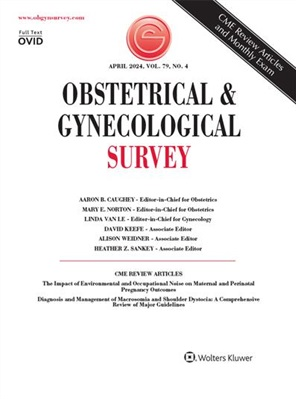Pain With Differing Insufflation Pressures During Robotic Sacrocolpopexy: A Randomized Controlled Trial
IF 4.3
4区 医学
Q1 OBSTETRICS & GYNECOLOGY
引用次数: 0
Abstract
ABSTRACT Pain after surgery may have different origins, such as incisions, affected viscera, surgical positioning, or peritoneal irritation from insufflation. Shoulder pain after gynecological laparoscopic surgery is a common concern thought to be associated with peritoneal irritation. Decreasing this pain is therefore a target for improvement of analgesic requirements and overall postoperative pain. This study aimed to determine changes in postoperative pain, surgical safety, and analgesic use via decreased insufflation pressures. The study was designed as a single-blinded, randomized clinical trial at a singular medical center within the United States where surgical treatment took place for pelvic organ prolapse via robotic-assisted sacrocolpopexy. Included were women 18 years or older who were able to complete the visual analog scale without assistance and who underwent scheduled robotic-assisted sacrocolpopexy. After inclusion, participants were randomized in a 1:1 ratio to undergo robotic-assisted sacrocolpopexy with peritoneal insufflation pressure at either 12 mm Hg (experimental) or 15 mm Hg (standard). Surgeries were performed by a single board-certified urogynecologist and resident assistant using a standard technique, the DaVinci Xi system, and an 8-mm AirSeal assist port. Surgeons and assisting OR professionals were not blinded to insufflation pressure. On the first postoperative day, all participants were asked to rate pain via a visual analog scale, as well as at 2 weeks postoperatively (with the addition of a PGI-I questionnaire). The 2-week surveys were collected by the principal investigator or primary surgeon (unblinded). A Likert scale of 0 to 10 was used to rate the highest preoperative and postoperative pain in the postanesthesia care unit. At the time of surgery, preoperative analgesia and opioid use were verified with active prescription records. After surgery, data were recorded for operative time, analgesic doses, conversion to laparotomy or increased insufflation pressure, additionally performed procedures, estimated blood loss, and length of stay. Enrollment occurred from April 27, 2021, to May 17, 2022, with final follow-up being completed on June 1, 2022. A total of 80 participants were enrolled, with 41 in the experimental insufflation group, and 39 in the standard insufflation group. Baseline differences did not exist between groups for prior abdominal surgeries, medical comorbidities, leading edge of prolapse, age, or body mass index. Although median preoperative pain was recorded as zero for both groups, the standard insufflation group did report a statistically higher pain level in the postoperative period. Furthermore, women in the experimental/lower insufflation group used statistically fewer morphine milliequivalents immediately after surgery as well as after discharge. There were no apparent operative problems significantly associated with lower insufflation pressures, as operative time, estimated blood loss, and length of stay in the hospital were not significantly different between groups. The analysis found that the use of 12 mm Hg insufflation pressure did lower opioid use and pain levels in comparison with 15 mm Hg in the immediate postoperative period. The use of this method proved both feasible and safe in all cases, without blood loss, operating time changes, or changes in completing cases through minimal invasive mess. These encouraging findings provide a zero-cost, surgeon-driven intervention method for the postoperative period of robotic gynecological surgeries with the potential lower patient pain levels and opioid use.机器人骶骶固定术中不同充气压力的疼痛:一项随机对照试验
术后疼痛可能有不同的原因,如切口、受累脏器、手术体位或腹膜充盈引起的刺激。妇科腹腔镜手术后肩痛是一个常见的问题,被认为与腹膜刺激有关。因此,减少这种疼痛是改善镇痛需求和整体术后疼痛的目标。本研究旨在通过降低充气压力来确定术后疼痛、手术安全性和镇痛药物使用的变化。该研究被设计为一项单盲、随机临床试验,在美国的一个医疗中心,通过机器人辅助的骶髋固定术对盆腔器官脱垂进行手术治疗。包括18岁或以上的女性,她们能够在没有帮助的情况下完成视觉模拟量表,并接受了预定的机器人辅助的骶髋固定术。纳入后,参与者以1:1的比例随机接受机器人辅助的骶colpop固定术,腹膜注入压力为12毫米汞柱(实验)或15毫米汞柱(标准)。外科医生和辅助手术室专业人员并没有对充气压力视而不见。在术后第一天,所有参与者都被要求通过视觉模拟量表对疼痛进行评分,以及在术后2周(增加了一份PGI-I问卷)。为期2周的调查由主要研究者或主要外科医生(非盲法)收集。使用0 - 10的李克特量表对麻醉后护理单元中最高的术前和术后疼痛进行评分。在手术时,术前镇痛和阿片类药物的使用通过有效处方记录进行验证。手术后,记录手术时间、镇痛剂量、转开腹或增加充气压力、额外手术、估计失血量和住院时间等数据。入组时间为2021年4月27日至2022年5月17日,最终随访于2022年6月1日完成。共纳入80例受试者,其中41例为实验充气组,39例为标准充气组。各组之间在既往腹部手术、医疗合并症、脱垂前沿、年龄或体重指数方面没有基线差异。虽然两组的术前疼痛中位数均为零,但标准充气组在术后期间确实报告了统计学上更高的疼痛水平。此外,实验/低注射量组的女性在手术后和出院后立即使用的吗啡毫当量在统计学上更少。由于手术时间、估计失血量和住院时间在两组之间没有显著差异,因此没有明显的手术问题与较低的充气压力显著相关。分析发现,与15毫米汞柱相比,术后立即使用12毫米汞柱充气压力确实降低了阿片类药物的使用和疼痛水平。该方法在所有病例中均被证明是可行和安全的,无出血量、手术时间的改变,也没有微创混乱导致完成病例的变化。这些令人鼓舞的发现为机器人妇科手术术后提供了一种零成本、外科医生驱动的干预方法,可能会降低患者的疼痛水平和阿片类药物的使用。
本文章由计算机程序翻译,如有差异,请以英文原文为准。
求助全文
约1分钟内获得全文
求助全文
来源期刊
CiteScore
2.70
自引率
3.20%
发文量
245
审稿时长
>12 weeks
期刊介绍:
Each monthly issue of Obstetrical & Gynecological Survey presents summaries of the most timely and clinically relevant research being published worldwide. These concise, easy-to-read summaries provide expert insight into how to apply the latest research to patient care. The accompanying editorial commentary puts the studies into perspective and supplies authoritative guidance. The result is a valuable, time-saving resource for busy clinicians.

 求助内容:
求助内容: 应助结果提醒方式:
应助结果提醒方式:


